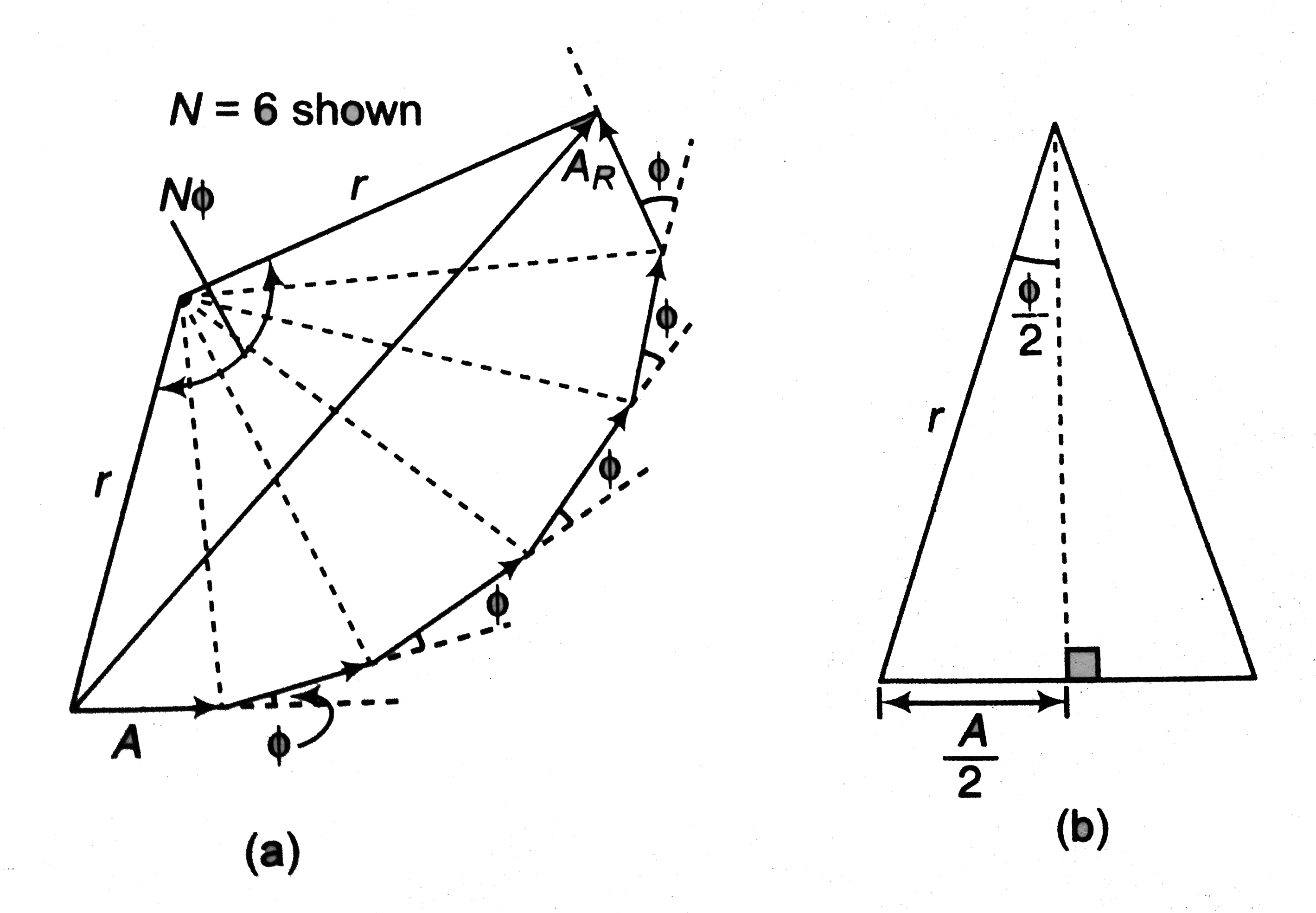Find the resultant amplitude and phase of a point at which N sinusoidal waves interfere. All the waves have same amplitude A and their phases increase in arithmetic progression of common difference ϕ.
The diagram for their sum is shown in figure for N=6. The resultant amplitudes is
AR. The apex angle of every isosceles triangle is ϕ. So, the angle subtended by the resultant is
Nϕ. Since, the heads of the vectors are all at the same distance r from the apex of the diagram.

From Fig. (a),
AR2=rsin(Nϕ)2
and from Fig. (b),
A2=rsin(ϕ2)
Dividing Eq. (i) by Eq. (ii), we get
ARA=sin(Nϕ)2sinϕ2
AR=A⎛⎜
⎜⎝sin(Nϕ2)sin(ϕ2)⎞⎟
⎟⎠s
Topper's Solved these Questions
- SUPERPOSITION OF WAVESBOOK - DC PANDEYCHAPTER - SUPERPOSITION OF WAVESEXERCISE - Exercise 18.1
3 Videos
- SUPERPOSITION OF WAVESBOOK - DC PANDEYCHAPTER - SUPERPOSITION OF WAVESEXERCISE - Exercise 18.2
4 Videos
- SUPERPOSITION OF WAVESBOOK - DC PANDEYCHAPTER - SUPERPOSITION OF WAVESEXERCISE - Example Type 4
1 Videos
- SOUND WAVESBOOK - DC PANDEYCHAPTER - SOUND WAVESEXERCISE - Exercise 19.7
4 Videos
- THERMOMETRY THERMAL EXPANSION AND KINETIC THEORY OF GASESBOOK - DC PANDEYCHAPTER - THERMOMETRY THERMAL EXPANSION AND KINETIC THEORY OF GASESEXERCISE - Medical entrance gallary
30 Videos
Similar Questions
The amplitude factor of resulting wave, formed by superposition of two sinusoidal waves of equal amplitude a and constant phase difference is given by
View SolutionThe resultant amplitude, when two waves of two waves of same frequency but with amplitudes a1 and a2 superimpose at phase difference of π/2 will be :-
View Solution
Knowledge Check
The amplitude factor of resulting wave, formed by superposition of two sinusoidal waves of equal amplitude a and constant phase difference is given by
A2acosϕB2acos(ϕ2)C2acos(ϕ3DZeroIf two waves of amplitude a produce a resultant wave of amplitude a then the phase difference between the is
A60∘––B90∘––C120∘––D180∘––The resultant amplitude, when two waves of two waves of same frequency but with amplitudes a1 and a2 superimpose at phase difference of π/2 will be :-
Aa1+a2Ba1−a2C√a21+a22Da21+a22
Determine the amplitudes of the resultant motion when two sinusoidal waves of same frequency , travelling in the same direction are combined . Their amplitudes are 3.0cmand4.0cm and they differ in phase by π/2radians.
View SolutionDetermine the amplitudes of the resultant motion when two sinusoidal waves of same frequency , travelling in the same direction are combined . Their amplitudes are 3.0cmand4.0cm and they differ in phase by π/2radians.
View SolutionTwo sinusoidal wave of the same frequency are to be sent in the same direction along a taut string. One wave has an amplitude of 5.0mm, the other 8.0mm. (a) What phase difference ϕ1 between the two waves results in the smallest amplitude of the resultant wave? (b) What is that smallest amplitude? (c) What phase difference ϕ2 results in the largest amplitude of the resultant wave ? (d) What is that largest amplitude? (e) What is resultant amplitude if the phase angle is (ϕ1−ϕ2)/2?
View SolutionTwo sinusoidal waves of the same frequency are to be sent in the same direction along a taut string. One wave has an amplitude of 5.50 mm, the other 12.0 mm. (a) What phase difference ϕ1 between the two waves results in the smallest amplitude of the resultant wave? (b) What is that smallest ! amplitude? (c) What phase difference ϕ2 results in the largest amplitude of the resultant wave? (d) What is that largest amplitude? (e) What is the resultant amplitude if the phase angle is (ϕ1−ϕ2)/2?
View SolutionTwo waves having sinusoidal waveforms have different wavelengths and different amplitude. They will be having
View Solution
